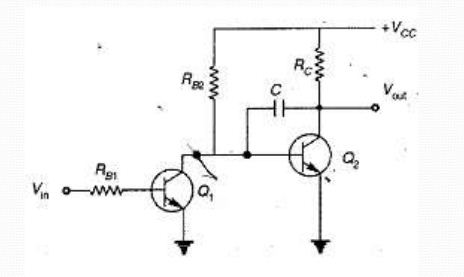How miller sweep circuit is work?
The miller circuit is also known as by the name of miller integrator. Above figure shows the circuit of the miller sweep circuit or miller integrator. The transistor Q1 act as a switch and transistor Q2 is a high gain amplifier. If the transistor Q1 is ON and transistor Q2 is OFF then the voltage across the capacitor and the output voltage is equal to VCC. At this time suppose a pulse of negative polarity as shown in figure b is applied at the base of the transistor Q1. Due to this emitter base junction of Q1 gets reverse biased and then it turns OFF and transistor Q2 is turn ON. As Q2 conducts the output voltage gradually moves towards zero. As the capacitor C is coupled to the base of the transistor Q2, the rate of decreases of the output voltage is controlled by the rate of discharge of a capacitor. The time constant of discharge is given by the relation,
π = RBC
The value of time constant is very large, the discharge current will be constant due to the run down of collector voltage is linear. The transistor Q1 turns ON while Q2 turns OFF when input pulse is removed. If the transistor Q1 turns OFF the capacitor C is charge quickly through resistor RC to VCC having a time constant π equal to RCC.
The resistance in the miller sweep (RC) is replaced by a diode. The diode forward resistance Rf helps the capacitor to charge quickly from VCC. Due to this playback time Tr of generated sweep is reduced. In this way the miller sweep circuit gives an excellent sweep linearity as compared to other sweep circuits.


